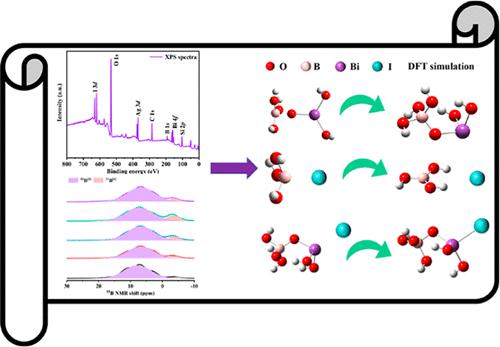当前位置:
X-MOL 学术
›
Inorg. Chem.
›
论文详情
Our official English website, www.x-mol.net, welcomes your feedback! (Note: you will need to create a separate account there.)
Bismuth Coordinates with Iodine Atoms to Form Chemical Bonds for Existing Stabilization in Boron Glass
Inorganic Chemistry ( IF 4.6 ) Pub Date : 2022-06-20 , DOI: 10.1021/acs.inorgchem.1c03680 Qian Wen 1 , Wencai Cheng 2, 3 , Meng Yan 2 , Yi Liu 4 , Zhentao Zhang 4 , Yi Xie 5 , Dadong Shao 6 , Xirui Lu 1, 2, 3
Inorganic Chemistry ( IF 4.6 ) Pub Date : 2022-06-20 , DOI: 10.1021/acs.inorgchem.1c03680 Qian Wen 1 , Wencai Cheng 2, 3 , Meng Yan 2 , Yi Liu 4 , Zhentao Zhang 4 , Yi Xie 5 , Dadong Shao 6 , Xirui Lu 1, 2, 3
Affiliation

|
Stabilizing radioactive iodine in boron glass for disposal was the ultimate goal of this study. In this study, bismuth was used near a monument. Thermogravimetric analysis showed that bismuth could remarkably stabilize iodine atoms in boron glass (only 3.74% of the mass was lost at 850 °C). Scanning electron microscopy–energy dispersive spectrometry images showed that most of the AgI was uniformly immobilized in the glass network. X-ray photoelectron spectrometry and NMR results confirmed the change in the coordination number of boron in the samples. The density functional theory calculation helped to understand the reason for the stable presence of iodine in boron glass. Iodine atoms were difficult to bond directly with boron atoms but tended to bond with bismuth atoms. From the spatial distribution of the structural molecular orbitals, it was observed that the bismuth atom releases electrons when stimulated, and the iodine atom needs to gain an electron to reach stability. At a low treatment temperature of 550 °C, the maximum density of the immobilized sample containing bismuth is 2.42 g·cm–3, and its iodine leaching rate at day 7 can be as low as 3.77 × 10–6 g·m–2·d–1. This study provides a way to improve the properties of boron glass microscopically in the future.
中文翻译:

铋与碘原子配位形成化学键,用于硼玻璃中的现有稳定性
稳定硼玻璃中的放射性碘以进行处置是本研究的最终目标。在这项研究中,在纪念碑附近使用了铋。热重分析表明,铋可以显着稳定硼玻璃中的碘原子(在 850 °C 时仅损失 3.74% 的质量)。扫描电子显微镜 - 能量色散光谱图像显示大部分 AgI 均匀地固定在玻璃网络中。X射线光电子能谱和核磁共振结果证实了样品中硼的配位数的变化。密度泛函理论计算有助于理解碘在硼玻璃中稳定存在的原因。碘原子难以与硼原子直接结合,但倾向于与铋原子结合。从结构分子轨道的空间分布来看,观察到铋原子在受激时会释放电子,碘原子需要获得一个电子才能达到稳定。在550 ℃的低温处理温度下,含铋的固定化样品的最大密度为2.42 g·cm–3,其第7天的碘浸出率可低至3.77 × 10 –6 g·m –2 ·d –1。该研究提供了一种未来在微观上改善硼玻璃性能的方法。
更新日期:2022-06-20
中文翻译:

铋与碘原子配位形成化学键,用于硼玻璃中的现有稳定性
稳定硼玻璃中的放射性碘以进行处置是本研究的最终目标。在这项研究中,在纪念碑附近使用了铋。热重分析表明,铋可以显着稳定硼玻璃中的碘原子(在 850 °C 时仅损失 3.74% 的质量)。扫描电子显微镜 - 能量色散光谱图像显示大部分 AgI 均匀地固定在玻璃网络中。X射线光电子能谱和核磁共振结果证实了样品中硼的配位数的变化。密度泛函理论计算有助于理解碘在硼玻璃中稳定存在的原因。碘原子难以与硼原子直接结合,但倾向于与铋原子结合。从结构分子轨道的空间分布来看,观察到铋原子在受激时会释放电子,碘原子需要获得一个电子才能达到稳定。在550 ℃的低温处理温度下,含铋的固定化样品的最大密度为2.42 g·cm–3,其第7天的碘浸出率可低至3.77 × 10 –6 g·m –2 ·d –1。该研究提供了一种未来在微观上改善硼玻璃性能的方法。



























 京公网安备 11010802027423号
京公网安备 11010802027423号